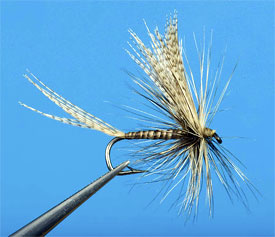

Originally Posted by
Byron haugh

How about any version of a comparadun?
How about any catskil style?
How about any Wulf fly?
I think we all grew up tying these flies and being exposed to them in literature to the extent that the upright wing became the accepted silhouette for a "well tied fly".
Of course, this all goes back to my assertion that the early tiers and fishers who were fishing relative virgin waters were spoiled in that the fish were less finicky due to little fishing pressure then.
Catskill:
This fly was tied by Theodore Gordon. The wing is canted as is the tail. So tradition was for a tilt for Catskill flies at least.

http://midcurrent.com/flies/quill-gordon/
Royal Wulff:

If the above Catskill and Wulff flies are supported by the tail and the tips of the palmered hackle, the body of the fly is tilted, front end up and the "wing" will be canted back like a mayfly natural.
As Steve said in another post, Ian Moutter believes the Catskill tail cannot support the the back of the hook and the back of Catskill fly will sink sink, tilting the wing further. This would especially be true of the Theodore Gordon tied fly. It would be true even if the fly had a vertical wing.
That is why Lee Wulff used deer hair for the tail of his Wulff series. If the tail floats the Wulff, as I believe it does, the wing is still tilted back because the hook is not parallel to the water.
Comparadun:
I will admit that the comparadun will initially be vertical. The tilt will depend on how the wing is tied in. With the tie in point in front of the wing, the wing will tend to slant backward; do the opposite and the wing will tend to slant forward. Even when Charlie Craven ties the wing so that the natural slant is forward, he forces it a bit backward.

Another factor that is rarely considered with these wings is how the fly looks after it has been cast. When the fly is being cast, the air pushes the fly wing backward at a slant. So the tendency with all upright wings is to be forced into a backward slant during casting and they slowly but gradually do develop this tilt.
Regards,
Silver
"Discovery consists of seeing what everybody has seen and thinking what nobody has thought"..........Szent-Gyorgy







 Reply With Quote
Reply With Quote